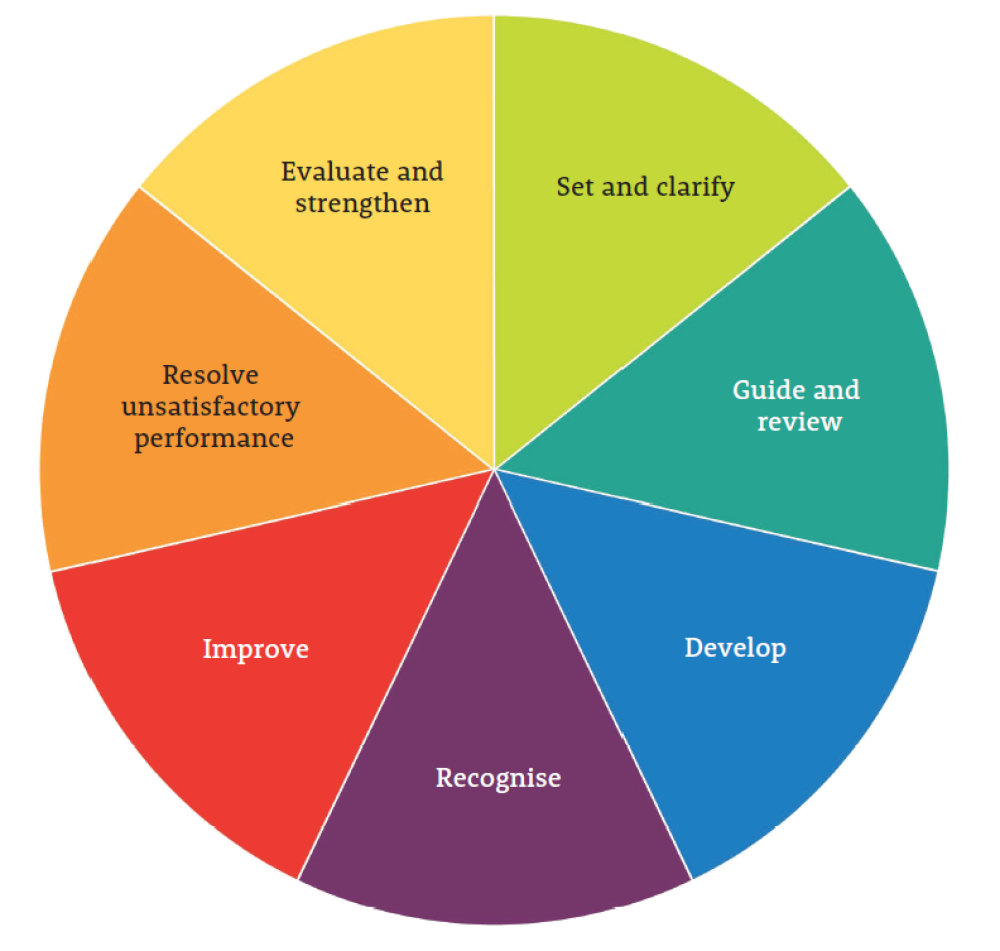The NSW government sector legislation requires all government sector agencies to have a performance management system in place for their employees that meets a set of core requirements and the essential elements set by the Public Service Commissioner.
The Performance Development Framework sets out benchmark expectations for performance management in the sector.
The framework contains seven core requirements with 19 corresponding essential elements which collectively:
- define baseline principles for agency performance management and development
- are applicable across different workforce types
- capture both organisational systems and effective people practices.
The essential elements describe behaviours and organisational approaches necessary for achieving outcomes. They articulate expectations of employees, people managers and the organisation, recognising there is shared responsibility for driving high performance.
Core requirements and essential elements of the framework
Core requirements | Essential elements |
Set and clarify expectations for employees Collaborative process to establish expectations and clarify performance objectives that align with the organisation’s direction. | - Mechanisms are in place to build employee awareness of, and adherence to, sector values and standards of ethical behaviour.
- People managers work with employees to clarify performance objectives, discuss the requirements and capabilities of the role, identify any concerns meeting objectives and establish how performance will be measured.
- Measurable performance objectives and expectations are appropriately recorded to promote accountability.
- Employee objectives are aligned with the organisation’s direction and support the delivery of business outcomes.
- Employees and people managers work together to establish shared expectations on the frequency and ways in which feedback will be provided.
|
Guide and review employee performance Regular practice of people managers and employees providing and receiving meaningful feedback to guide performance, review progress and align performance objectives. | - People managers regularly engage employees in open, honest conversations and provide constructive, ongoing performance feedback.
- People managers invite suggestions and feedback from team members and work to create an inclusive environment where diverse perspectives are valued.
- Employees and people managers jointly review performance objectives and adjustments are made as required to maintain alignment with organisational needs and priorities.
- Overall assessment of performance is made against objectives and capabilities by people managers and scheduled reviews with employees are held during the review period.
|
Develop employee capability Recurring initiatives to engage employees in working proactively with people managers to identify and plan for their own capability development. | - Employees work collaboratively with people managers to identify development goals and targeted capability development options for both current and future roles.
- Employees are encouraged to work proactively with people managers to plan for their own development, assess progress and maximise opportunities to develop capability strengths and close gaps.
|
Recognise employee achievements Organisational practices to encourage appropriate ways of recognising the achievements of employees and teams. | - The organisation has support mechanisms in place for people managers to select appropriate ways of recognising team and employee achievements.
- Employees are encouraged to celebrate team efforts and give recognition to the achievement of others.
|
Improve employee performance Actions to identify and support the emerging performance improvement needs of employees. | - If there are instances where employee performance is below the standard required for the role, people managers and employees proactively identify and discuss the issue/s, share targeted feedback and re-examine expectations.
- Employees proactively share issues that may impact their performance and are provided with support to address the issues and participate in actions towards improving performance.
|
Resolve unsatisfactory employee performance Efforts to determine and address unsatisfactory performance. | - People managers and the organisation work promptly with the employee to determine and resolve patterns of unsatisfactory performance.
|
Evaluate and strengthen practices Organisational mechanisms in place to support, monitor and evaluate the effectiveness of performance systems and practices. | - The organisation has approaches in place to measure the effectiveness and impact of its people managers, identify trends and inform ongoing investment to support effective performance practices.
- The organisation has established methods to enable use of performance information as an input for other workforce management processes.
- Organisational expectations of performance outcomes are clearly communicated, monitored and evaluated to support ongoing achievement and improvement.
|
